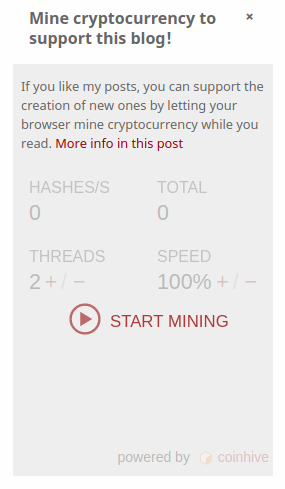Long-time readers will notice a new addition to the left side of the blog – a small piece of text just under the header:

Click on it and you’ll see something like this:

This is an experiment in blog monetisation, powered by Coinhive. The traditional easiest way to monetise a blog is to toss some adverts here and there – above, below, beside and interleaved with the content.
I’ve never run anything like that on this blog because I hate advertising. I use an adblocker wherever possible online and use streaming and podcasts to avoid ad-saturated media like television and radio. I’ve gotten to the point where I feel physically upset if I see or (especially) hear an advert. So I figured it would be hypocritical to run ads on my own blog (plus I didn’t want to ruin the clean black and white theme).
The strongest argument against adblocking, and one I don’t have a solid rebuttal for, is that it’s the only good way to fund the production of free web content. And I love free web content (who doesn’t?) especially written content. Not that I’m completely averse to paying for content, but it tends to be a lot of effort and I’m not used to having to. It’s not the norm on the web.
The web is much better at making information free than making it expensive.
Matthew Butterick, The Bomb in the Garden
Computers and the internet have just about destroyed the marginal cost of media. The second through nth copy of an article, video, book, movie, song, game, etc, is free. It’s as simple as “right click → Copy”.1 The catch is that you still have to produce the original, and that’s not free: it takes time and expertise, and there’s only so much time and expertise that requires no compensation available in the world.
The reason advertising has worked as well as it has for as long as it has – it’s only really started to run up against trouble with the advent of adblocking (and this is a battle advertising will ultimately lose) – is that it’s easy for the consumer. Advertisers pay to place their ads next to articles, users read articles and see ads. No-one has to reach for their credit card.
In the most widespread online ad revenue models, sites running ads are paid per click. In order for the advertisers to agree to this model, there needs to be some assurance that these clicks are genuine engagements with potential customers, rather than just the site owner frantically clicking around to give themself a bigger pay-day.
Sometimes, well-intentioned visitors to a given site will click a couple of arbitrary ads with the sole aim of giving the site more revenue (“Hey dude, liked your post so I clicked some ads!”). Because of the way the model works, this is technically click fraud. So as a result, any visitor wanting to support a site but not to the point where they make a microtransaction/donation (which isn’t always possible in any case) can only do so by doing something with “fraud” in its name.
Hence opt-in2 JavaScript cryptocurrency mining. If you like my writing and want to show that appreciation, all you have to do is click START MINING and spend some CPU cycles verifying transactions on the Monero blockchain on my behalf. You can turn on the miner while you read a post, and it’ll turn off as soon as you leave the page. You’re free to tweak the number of threads used (I’ve set the default to a modest two) and the mining speed and you can stop mining whenever you want. You’re also free to ignore it completely – this site will not mine cryptocurrency without your knowledge and consent.
To be clear, this is not 100% free for you. You’re not directly giving me your money, but mining cryptocurrency will spin up your CPU, causing it to draw more electricity, which you or someone near you ultimately has to pay for. Of course, five minutes of low-intensity mining while you read a blogpost won’t make a noticeable difference to your powerbill, but it’s something to keep in mind. Adoring fans: please don’t run sixteen threads at 100% for the entire month (without budgeting for it).
But before I talk you out of running the miner, consider: this site is relatively light on resources without the miner.3 The only JavaScript is the Google Analytics and Search Engine stuff, a couple of Cloudflare things and now this miner. Many other sites – most big news websites for example – are much worse.
Sites run tens of different trackers and active advertisements. Clientside JavaScript frameworks are used to dynamically build and render pages of static text. The web is bloated. JavaScript is wasting your CPU cycles already, so why not mine a little cryptocurrency? I promise you won’t have to look at any garish product-pushing animations or listen to annoying voices try persuade you to buy stuff.
Who knows, maybe this is the future of funding free content on the web?
-
Subject for a future post: DRM and piracy. ↩︎
-
So not like what happened with Showtime or Piratebay. ↩︎
-
That said, there’s still lots of room for improvement. I’m pretty lazy about compressing and resizing images, which does the site’s loadtime no favours. ↩︎
 David Yates.
David Yates.
 ♥
♥